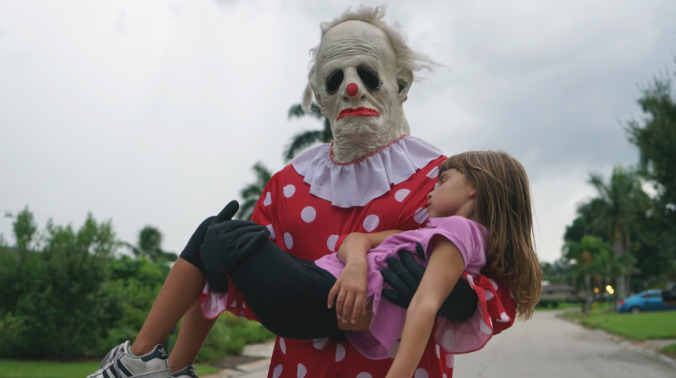How do you make a real-life evil clown boring? Just call Wrinkles The Clown
Film Reviews moviereview

Warning: In so much as a documentary can contain major “plot points,” this review reveals them.
It’s unfair and even a little mean to spoil a narrative film’s twists and surprises. But when a twist is manufactured for a documentary—a medium whose relationship to the truth is right there in its status as a “document”—it seems unfair not to offer at least a minor warning. Without fully revealing Wrinkles The Clown’s abrupt mid-film reveal (yet), it’s worth noting that the film doesn’t simply showcase a discovery that it made during filming. It deliberately manufactures and misdirects to the point that the idea of “documentary” is nearly shredded altogether. With the right story and done the right way, such a gambit can been a laudable and interesting. Exit Through The Gift Shop, for example, takes a shadowy main character and adds layers, artfully building a mystery in which the veracity takes a backseat to enjoyment. F For Fake, on the other hand, found itself in the middle of real-life developments and turned it into a story about the very idea of fakery. With Wrinkles, there’s no clear (or even muddled) sense that its deception holds any real purpose, thereby rendering huge chunks of its first hour pretty pointless.
It’s too bad, because the story of Wrinkles The Clown and the public reaction to his antics is funny, weird, and timely—there may just not be enough of it to warrant a feature-length doc. In 2015, videos of a spooky clown in Florida began surfacing, including a particularly creepy—though obviously staged—clip in which the clown emerges from underneath a little girl’s bed, creepily lords over her, puts down a toy, and then disables the security camera filming him. It’s stylish and spooky, and would’ve made a great scene in a horror movie. Jimmy Kimmel and James Corden (along with local Florida press) gave it some attention. Other videos followed, as did a marketing campaign featuring a website of Wrinkles sightings and Obey Giant-level stickering of his Southwest Florida stomping grounds. Those seemingly omnipresent stickers featured Wrinkles’ phone number, and the clown claimed to offer child-scaring services to beleaguered parents. Threaten your kids with a killer clown, he seemed to advertise, and they’ll never misbehave again.
Wrinkles’ phone, if Wrinkles The Clown is to be believed, started ringing off the hook with everything from paying customers to virulent haters to offers of blowjobs. Kids wanted to see if the clown would answer, and parents were either amused or angry. We’re introduced early on to Wrinkles himself, whose face is never seen and who disguises his voice as a cartoonish blend of Moe Syzlak and The Sopranos. His life is plainly sad: He’s a senior citizen whose dinner comes from the microwave, whose TV is an old black-and-white, and who literally lives in a van down by the river. It all seems a little too perfectly pathetic.
Meanwhile, Wrinkles The Clown heads off on a series of diversions that offer some fun context and more concrete details. A folklorist and a clown expert offer their takes on both the history of clowning and the spreading of scary legends. News footage reveals the existence of Wrinkles copycats whose ideas of fun are edgier than those of the clown they’re inspired by. And we meet three young kids, raised on YouTube, who find the legend of Wrinkles both fascinating and scary. One seems scared enough to threaten him, another wants to follow in his footsteps and eventually make clown videos of his own. None of them do much to advance the story.
Pretty late in the game, we learn—spoiler alert—that the pathetic old man isn’t Wrinkles at all, but an actor portraying an entirely false history. We meet the “real” Wrinkles (maybe?) though only in shadow, and only with his silly fake voice. It’s more of a “huh?” moment than an “ahh!” one. He seems like a nice guy whose funny idea got more traction than he bargained for, and who’s confused about how and whether to take advantage of it. Wrinkles The Clown doesn’t tie these two halves together in any meaningful way. The movie feints at exploring evolving mythologies, but never scratches away more than a surface layer of pancake makeup. It could have at least alluded to the idea that clowns hide their identities for a living. Instead, it explains the deception only vaguely, with the idea that the old man Wrinkles was what its clearly much younger creator thought a “real” Wrinkles might be like. But the ruse never feels like more than an afterthought.
Wrinkles also speaks eloquently about how people love and hate the character, but there’s not much evidence here that his stunts, fun and silly though they were, created more than tiny blips on the pop-culture radar. If they did have some bigger impact or importance, it’s not obvious. And if a documentary is going to be deliberately deceptive, it better have a point to make—or at least be fantastically entertaining. Wrinkles The Clown has only the vaguest of justifications for its misdirection, which ultimately proves much less entertaining than a movie about a creepy clown who terrorizes misbehaving children ought to be.